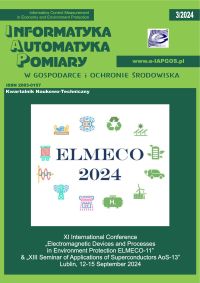POPRAWA ZDROWIA UPRAW DZIĘKI CYFROWEMU BLIŹNIAKOWI DO MONITOROWANIA CHORÓB I RÓWNOWAGI SKŁADNIKÓW ODŻYWCZYCH
Sobhana Mummaneni
Velagapudi Ramakrishna Siddhartha Engineering College, Department of Computer Science and Engineering (Indie)
https://orcid.org/0000-0001-5938-5740
Tribhuvana Sree Sappa
tribhuvanasree@gmail.comVelagapudi Ramakrishna Siddhartha Engineering College, Department of Computer Science and Engineering (Indie)
https://orcid.org/0009-0009-8594-429X
Venkata Gayathri Devi Katakam
Velagapudi Ramakrishna Siddhartha Engineering College, Department of Computer Science and Engineering (Indie)
https://orcid.org/0009-0002-3492-4386
Abstrakt
Cyfrowe bliźniaki do cyfrowa replika obiektu fizycznego, która umożliwia obserwację jego działania w czasie rzeczywistym, gromadzenie danych i rekomendowanie działań naprawczych, jeśli jest to wymagane w celu poprawy jego wydajności. Ta fascynująca koncepcja technologiczna dociera obecnie do dziedzin rolnictwa, aby przekształcić rolnictwo, tworząc cyfrowe bliźniaki całych gospodarstw. Inicjatywa ta przedstawia innowacyjną strategię mającą na celu poprawę zdrowia i plonów upraw poprzez stworzenie cyfrowego bliźniaka pól ryżowych. Celem jest umożliwienie wczesnego wykrywania niedoborów składników odżywczych i zarazy liści, co doprowadzi do transformacji rolnictwa. Tworząc wirtualne repliki roślin i pól, cyfrowy bliźniak wykorzystuje dane w czasie rzeczywistym i zaawansowane analizy, aby zmienić sposób zarządzania systemami rolniczymi. Dzięki integracji teledetekcji, analizy danych i różnych urządzeń Internetu rzeczy, takich jak czujniki pH, azotu, potasu i fosforu, w połączeniu z systemem bramek, cyfrowy bliźniak zapewnia monitorowanie i analizę stanu upraw i poziomów składników odżywczych w czasie rzeczywistym. Zastosowanie zaawansowanych algorytmów uczenia maszynowego, w szczególności konwolucyjnych sieci neuronowych, zapewnia precyzyjne i wczesne wykrywanie niedoborów składników odżywczych i chorób upraw. Ta przełomowa technologia zapewnia rolnikom aktualne alerty i przydatne informacje, umożliwiając proaktywne podejmowanie decyzji w celu optymalnego zarządzania uprawami. Ten cyfrowy bliźniak pól uprawnych reprezentuje transformacyjne podejście do zrównoważonego rozwoju rolnictwa i zwiększania produktywności.
Słowa kluczowe:
zrównoważony rozwój rolnictwa, konwolucyjne sieci neuronowe, cyfrowy bliźniak, internet rzeczy, wykrywanie niedoboru składników odżywczychBibliografia
Abbas A. et al.: Drones in Plant Disease Assessment, Efficient Monitoring, and Detection: A Way Forward to Smart Agriculture. Agronomy 13(6), 2023, 1524.
Google Scholar
Asibi A. E., Chai Q., Coulter J. A.: Rice blast: A disease with implications for global food security. Agronomy 9(8), 2019, 451.
Google Scholar
Awan J.: Digital Twins for Agriculture - Blog Des Fraunhofer IESE. Fraunhofer IESE, 25 Nov. 2020 [www.iese.fraunhofer.de/blog/digital-twins-agriculture] (avaible 29.09.2023).
Google Scholar
Bastiaans L.: Effects of leaf blast on growth and production of a rice crop: 1. Determining the mechanism of yield reduction. Netherlands Journal of Plant Pathology 99, 1993, 323–334.
Google Scholar
Blast (Leaf and Collar), IRRI Rice Knowledge Bank. [www.knowledgebank.irri.org,www.knowledgebank.irri.org/training/fact-sheets/pest-management/diseases/item/blast-leaf-collar] (avaible 29.09.2023).
Google Scholar
Bravo C. et al.: Early disease detection in wheat fields using spectral reflectance. Biosystems Engineering 84(2), 2003, 137–145.
Google Scholar
Chaux J. D. et al.: A digital twin architecture to optimize productivity within controlled environment agriculture. Applied Sciences 11(19), 2021, 8875.
Google Scholar
Jose A. et al.: Detection and classification of nutrient deficiencies in plants using machine learning. Journal of Physics: Conference Series 1850(1), 2021.
Google Scholar
Kalaji H. M. et al.: Chlorophyll fluorescence as a tool for nutrient status identification in rapeseed plants. Photosynthesis Research 136, 2018, 329–343.
Google Scholar
Latte M. V., Shidnal S., Anami B. S.: Rule based approach to determine nutrient deficiency in paddy leaf images. International Journal of Agricultural Technology 13(2), 2017, 227–245.
Google Scholar
Lau H. Y., Botella J. R.: Advanced DNA-based point-of-care diagnostic methods for plant diseases detection. Frontiers in plant science 8, 2017.
Google Scholar
Nayak A. et al.: Application of smartphone-image processing and transfer learning for rice disease and nutrient deficiency detection. Smart Agricultural Technology 4, 2023, 100195.
Google Scholar
Nutrient-Deficiency-Symptoms-In-Rice. [www.kaggle.com/datasets/guy007/nutrientdeficiencysymptomsinrice] (avaible 27.09.2023).
Google Scholar
Paiman J. et al.: Maximizing the Rice Yield (Oryza Sativa L.) Using NPK Fertilizer. The Open Agriculture Journal 15(1), 2021, 33–38, [https://doi.org/10.2174/1874331502115010033].
Google Scholar
Peladarinos N. et al.: Enhancing smart agriculture by implementing digital twins: A comprehensive review. Sensors 23(16), 2023, 7128.
Google Scholar
Rice Blast, Rice, Agriculture: Pest Management Guidelines. UC Statewide IPM Program (UC IPM) [ipm.ucanr.edu/agriculture/rice/rice-blast] (avaible 29.09.2023).
Google Scholar
Rice Diseases Image Dataset [www.kaggle.com/datasets/minhhuy2810/rice-diseases-image-dataset] (avaible 29.09.2023).
Google Scholar
Rice Production by Country. World Agricultural Production 2023/2024 [www.worldagriculturalproduction.com/crops/rice.aspx] (avaible 29.09.2023).
Google Scholar
Shivappa R. et al.: Emerging minor diseases of rice in India: losses and management strategies. Integrative Advances in Rice Research, 2021.
Google Scholar
Talukder Md S. H. et al.: An Improved Model for Nutrient Deficiency Diagnosis of Rice Plant by Ensemble Learning. 4th International Conference on Sustainable Technologies for Industry 4.0 (STI). IEEE, 2022.
Google Scholar
Terentev A., Dolzhenko V.: Can Metabolomic Approaches Become a Tool for Improving Early Plant Disease Detection and Diagnosis with Modern Remote Sensing Methods? A Review. Sensors 23(12), 2023, 5366.
Google Scholar
Wang C. et al.: Classification of nutrient deficiency in rice based on CNN model with Reinforcement Learning augmentation. International Symposium on Artificial Intelligence and its Application on Media (ISAIAM). IEEE, 2021.
Google Scholar
Xu Z. et al.: Using deep convolutional neural networks for image-based diagnosis of nutrient deficiencies in rice. Computational Intelligence and Neuroscience, 2020, 7307252.
Google Scholar
Autorzy
Sobhana MummaneniVelagapudi Ramakrishna Siddhartha Engineering College, Department of Computer Science and Engineering Indie
https://orcid.org/0000-0001-5938-5740
Autorzy
Tribhuvana Sree Sappatribhuvanasree@gmail.com
Velagapudi Ramakrishna Siddhartha Engineering College, Department of Computer Science and Engineering Indie
https://orcid.org/0009-0009-8594-429X
Autorzy
Venkata Gayathri Devi KatakamVelagapudi Ramakrishna Siddhartha Engineering College, Department of Computer Science and Engineering Indie
https://orcid.org/0009-0002-3492-4386
Statystyki
Abstract views: 291PDF downloads: 233
Inne teksty tego samego autora
- Sobhana Mummaneni, Sasi Tilak Ravi, Jashwanth Bodedla, Sree Ram Vemulapalli, Gnana Sri Kowsik Varma Jagathapurao, KOMPLEKSOWE BADANIE: WYKRYWANIE TĘTNIAKA WEWNĄTRZCZASZKOWEGO ZA POMOCĄ HYBRYDOWEGO GŁĘBOKIEGO UCZENIA SIĘ VGG16-DENSENET NA OBRAZACH DSA , Informatyka, Automatyka, Pomiary w Gospodarce i Ochronie Środowiska: Tom 14 Nr 1 (2024)
- Sobhana Mummaneni, Pragathi Dodda, Naga Deepika Ginjupalli, INSPIROWANE KOJOTAMI PODEJŚCIE DO PRZEWIDYWANIA TOCZNIA RUMIENIOWATEGO UKŁADOWEGO Z WYKORZYSTANIEM SIECI NEURONOWYCH , Informatyka, Automatyka, Pomiary w Gospodarce i Ochronie Środowiska: Tom 14 Nr 2 (2024)









